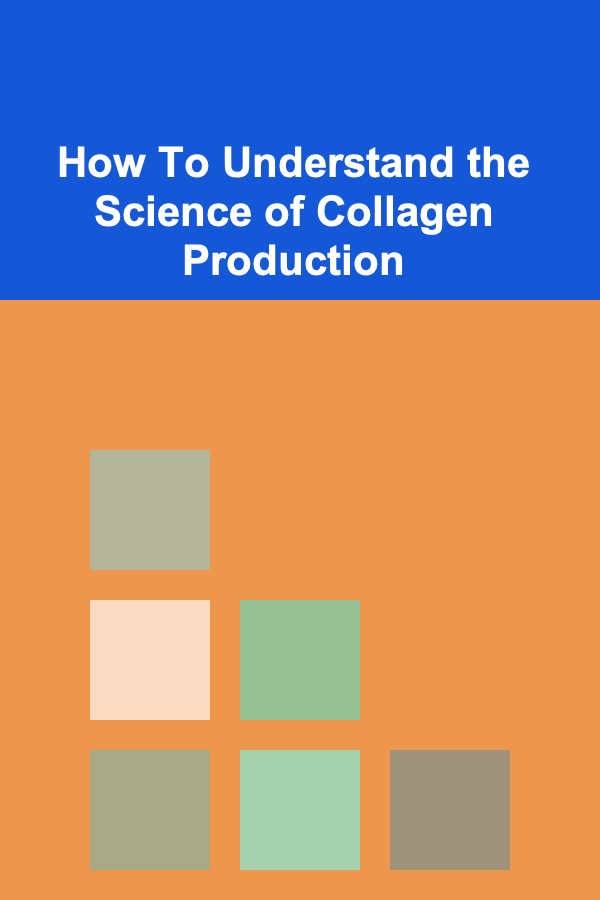
How To Understand the Science of Collagen Production
ebook include PDF & Audio bundle (Micro Guide)
$12.99$8.99
Limited Time Offer! Order within the next:

Collagen is one of the most abundant proteins in the human body, serving as a fundamental structural component for tissues, skin, bones, tendons, and cartilage. As we age, the natural production of collagen in our body begins to decrease, leading to common signs of aging like wrinkles, sagging skin, and joint discomfort. Understanding the science of collagen production is essential for comprehending how it contributes to the body's overall health and how we can support its natural production through lifestyle choices, nutrition, and supplementation.
This article will explore the intricate biological processes behind collagen synthesis, factors affecting its production, and how we can maintain healthy collagen levels throughout life.
What is Collagen?
Collagen is a structural protein made up of amino acids and plays an essential role in maintaining the strength, elasticity, and structure of various tissues in the body. It is composed mainly of three amino acids: glycine, proline, and hydroxyproline. These amino acids form a triple-helix structure that provides collagen with its characteristic strength and flexibility.
There are at least 28 types of collagen in the body, but types I, II, and III are the most common and have the most significant roles. Type I collagen is found in the skin, tendons, bones, and other tissues, while type II collagen is found primarily in cartilage, and type III collagen is found in muscles, arteries, and organs.
Collagen's primary functions include:
- Structural Integrity: Collagen fibers provide structure to tissues and organs.
- Elasticity: Collagen contributes to skin elasticity and joint flexibility.
- Tissue Repair: Collagen plays a role in the healing and regeneration of tissues.
The Collagen Production Process
Collagen production in the body involves a series of complex biochemical processes that primarily occur in fibroblasts, which are specialized cells responsible for synthesizing collagen in connective tissues.
Step 1: Amino Acid Synthesis
The first step in collagen production begins with the synthesis of amino acids. These amino acids are derived from the foods we consume. The most critical amino acids for collagen production are glycine, proline, and lysine. Glycine, in particular, is the most abundant amino acid in collagen and accounts for about one-third of the collagen molecule. Proline and lysine contribute to the formation of collagen's triple-helix structure.
Step 2: Formation of Procollagen
Once the amino acids are available, they are assembled into a precursor protein called procollagen. Procollagen is formed in the rough endoplasmic reticulum (ER) of fibroblasts. This molecule contains additional peptide sequences that prevent collagen fibers from assembling prematurely. At this stage, procollagen consists of three polypeptide chains that are bound together in a triple-helix structure.
Step 3: Hydroxylation
In the next phase of collagen synthesis, hydroxylation occurs. This process is crucial for the stability of the collagen structure. The amino acids proline and lysine are hydroxylated in a reaction that requires vitamin C (ascorbic acid) as a cofactor. This addition of hydroxyl groups (-OH) to proline and lysine residues enhances the stability of the collagen molecules.
Vitamin C is particularly vital during this step, as a deficiency in vitamin C leads to impaired collagen production and conditions like scurvy, where connective tissues break down due to weak collagen.
Step 4: Secretion of Procollagen
After hydroxylation, procollagen molecules are packaged into vesicles and transported to the Golgi apparatus, where they are modified further. The modified procollagen molecules are then secreted from the fibroblasts into the extracellular space.
Step 5: Formation of Tropocollagen
Once outside the cell, procollagen undergoes an enzymatic process that removes the additional peptide sequences, converting it into tropocollagen. Tropocollagen is the basic building block of collagen fibers.
Step 6: Collagen Fibril Formation
The final step in collagen production is the aggregation of tropocollagen molecules into collagen fibrils. These fibrils align in parallel, creating a strong, organized network. The fibrils are cross-linked by covalent bonds formed between the amino acids, which provide additional strength and stability to the collagen fibers.
Step 7: Maturation and Cross-Linking
Collagen fibrils mature and become even stronger through cross-linking. This process involves the formation of bonds between the tropocollagen molecules, which ultimately create a more robust and durable collagen structure. The cross-links in collagen fibers give them their tensile strength, which is essential for maintaining tissue integrity and resistance to physical stress.
Factors Affecting Collagen Production
While the body continuously produces collagen, several factors can either enhance or inhibit collagen synthesis. These factors can be internal (genetic) or external (environmental and lifestyle-related).
Age
As we age, collagen production naturally decreases, primarily because of changes in fibroblast activity and a reduced ability to synthesize amino acids essential for collagen production. By the time we reach our late 20s or early 30s, collagen production begins to decline. This leads to common signs of aging, such as wrinkles, sagging skin, and reduced joint flexibility.
Genetics
Our genetic makeup plays a significant role in how much collagen our bodies can produce. Some people are genetically predisposed to produce higher amounts of collagen and have more resilient skin and joints, while others may experience a more rapid decline in collagen production as they age.
Diet
What we eat can significantly impact collagen production. Certain nutrients are vital for collagen synthesis:
- Vitamin C: As mentioned, vitamin C is essential for hydroxylating proline and lysine residues, which are crucial for collagen stability.
- Amino Acids: Consuming foods rich in glycine, proline, and lysine can support collagen production. Bone broth, lean meats, and dairy are excellent sources of these amino acids.
- Copper: Copper is a trace mineral that plays a key role in collagen cross-linking. Foods like shellfish, nuts, and seeds can provide copper.
- Antioxidants: Antioxidants, such as vitamins A and E, can help protect collagen fibers from oxidative damage caused by free radicals, thus supporting collagen integrity.
UV Exposure
Exposure to ultraviolet (UV) light from the sun is one of the most significant external factors that degrade collagen. UV rays can break down collagen fibers in the skin through a process called photoaging. UV exposure triggers the production of enzymes known as matrix metalloproteinases (MMPs), which degrade collagen and elastin, leading to wrinkles and skin sagging.
Smoking
Smoking accelerates the breakdown of collagen in the skin and other tissues. The chemicals in tobacco smoke, including nicotine, reduce blood flow to the skin, impairing nutrient and oxygen delivery to collagen-producing cells. Smoking also promotes the release of MMPs, which degrade collagen.
Stress
Chronic stress can influence collagen production by raising cortisol levels in the body. Elevated cortisol levels can impair collagen synthesis and promote collagen breakdown, contributing to premature aging and other health issues.
Hormones
Hormones like estrogen play a crucial role in collagen production. As women approach menopause, the decrease in estrogen levels leads to a decline in collagen production. This results in increased skin laxity and the development of wrinkles.
Inflammation
Chronic inflammation, whether due to autoimmune conditions, infections, or other factors, can reduce collagen production. Inflammatory cytokines can interfere with fibroblast function and promote the breakdown of collagen fibers.
Supporting Collagen Production
While some factors affecting collagen production, such as age and genetics, cannot be controlled, there are several ways to support and enhance collagen production throughout life.
1. Nutrition and Supplements
Proper nutrition plays a crucial role in promoting healthy collagen production. Consuming a balanced diet rich in collagen-boosting nutrients can support the body's natural ability to produce collagen.
Collagen supplements, such as hydrolyzed collagen peptides, have become popular in recent years. These supplements are broken down into smaller peptides, making them more easily absorbed by the body. Studies have shown that collagen supplements can improve skin elasticity, reduce wrinkles, and promote joint health.
2. Protecting from UV Exposure
To protect collagen in the skin, it is essential to minimize UV exposure. Wearing sunscreen with broad-spectrum protection, using protective clothing, and seeking shade during peak sunlight hours can help preserve collagen in the skin.
3. Quit Smoking
Quitting smoking can have immediate benefits for skin health and collagen production. By improving blood circulation to the skin and reducing inflammation, individuals can promote healthier collagen production.
4. Stress Management
Engaging in stress-reducing activities, such as yoga, meditation, or deep breathing exercises, can help lower cortisol levels and support collagen production.
5. Regular Exercise
Regular physical activity can enhance circulation and promote the delivery of nutrients to the skin and other tissues, helping support collagen production.
Conclusion
Collagen is a vital protein that plays a crucial role in maintaining the structural integrity and function of our tissues. Understanding the science of collagen production, including the biochemical processes involved, the factors that influence collagen synthesis, and how to support its production, can help us maintain healthy collagen levels throughout life. By prioritizing proper nutrition, protecting our skin from UV damage, quitting smoking, and managing stress, we can support our body's natural ability to produce collagen, promoting youthful, healthy skin, strong joints, and overall well-being.

How to Clean Your Windows Like a Pro
Read More
How to Deal with Pet Separation Anxiety in Your Home
Read More
How to Make a Checklist for Preparing for a Panel Interview
Read More
How to Understand the Life Cycle of Crabs
Read More
How To Shoot Cinematic Video Footage
Read More
How to Plan Your Pilates Progress: A Month-by-Month Guide
Read MoreOther Products

How to Clean Your Windows Like a Pro
Read More
How to Deal with Pet Separation Anxiety in Your Home
Read More
How to Make a Checklist for Preparing for a Panel Interview
Read More
How to Understand the Life Cycle of Crabs
Read More
How To Shoot Cinematic Video Footage
Read More